Get free search engine traffic to your blog with this WordPress SEO guide for beginners. WordPress SEO is an essential first step after you start your blog. Before starting to write your blog content there are basic steps that need to be set up on your website. Otherwise your content may not get any free search engine traffic.
If you have not started a blog yet then check my blog starter guide first then come here to optimize WordPress for SEO.
As I mentioned before, this guide is for beginner’s. If you are an experienced blogger then you can skip details and check heading to find out if anything important is missing from your blog SEO.
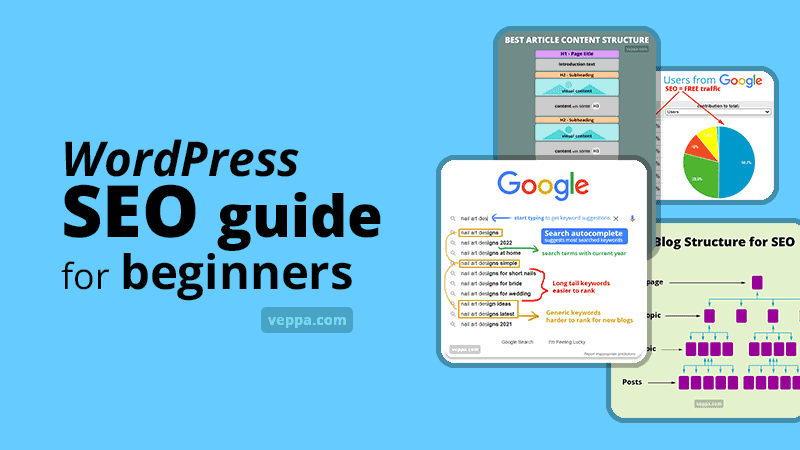
You will learn:
- How to allow google to index your content.
- Add your website to google search.
- Learn how to write optimized content.
- What is needed to get more visitors from google.
- Learn to use 4 free SEO tools (check tools if you are in a rush)
Blog is a tool for presenting your knowledge to the world. Imagine blogging as writing a book. You write a great book, spend lots of time writing it, but do not tell anybody about it. It is full of helpful information but nobody is aware of it. Then you expect people to read it and wait a couple months. Nobody reads it and you get upset.
Do you see a missing part in this story that made you upset? All your effort, your experience and knowledge is not found and not helpful to people. Why? Because you did not tell anybody about your book (content).
Google is a tool to share your content with everybody in the World. Your content is indexed and shown to people searching for it. It is available 24 hours a day all year long for many years. Google is a traffic source for your blog content. It is free, it is relevant, it is a focused audience for your content.
Why do websites need SEO?
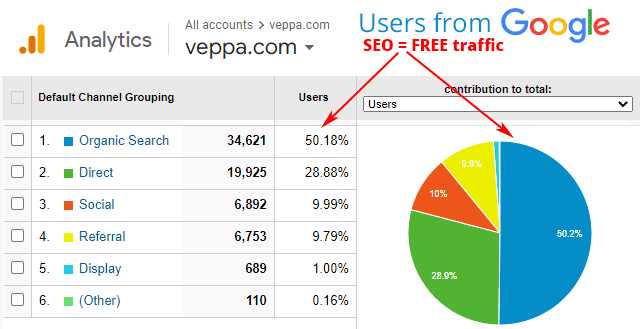
Check this report from google analytics. 50% of all visitors to my blog come from search engines. It is free traffic that will come to your blog if you do proper SEO. Now let’s start optimizing your website.
Table of Contents
Basics of Search engine optimization
Before we start, let’s explain some basic terms used in SEO. We will be using them while we optimize your blog for SEO.
What is SEO?
Search engine optimization (SEO) is the process of improving the quality and quantity of website traffic to a website or a web page from search engines. (Wikipedia)
You need to optimize your blog and your articles in order to get indexed by google. Your content then will be shown to related search terms and users searching for information will come to your website.
How does a search engine work?
There are 3 main steps that search engine performs:
- Google spiders crawl the web by visiting web pages.
- Optimized web pages stored in google index, grouped and ranked using information collected about the page.
- When searched google shows best results based on search terms and page rank.
Our goal is to optimize our pages so they will be indexed, grouped and ranked correctly by google. Optimization for indexing and grouping is not difficult. Optimization for ranking is very competitive. Because your content will be competing with many other peoples’ optimized content.
Basic SEO terms
We know what SEO is and how google works. Now let’s learn some basic SEO terms that you will come across when learning to optimize your blog.
- On-site SEO is optimization done on your website, in your content, keywords used on your website, internal links, technical features of your website.
- Off-site SEO is promotions of your content outside of your website. This is content or media, like video, promoting and linking to your relevant pages.
- Backlinks are links coming to your content from other websites. It is like a voting system for ranking your content. More relevant links from high ranking websites you have higher your page rank will be.
All this SEO should be used in a way that is not fooling or tricking search engines. This is known as white hat SEO.
Search engine ranking factors
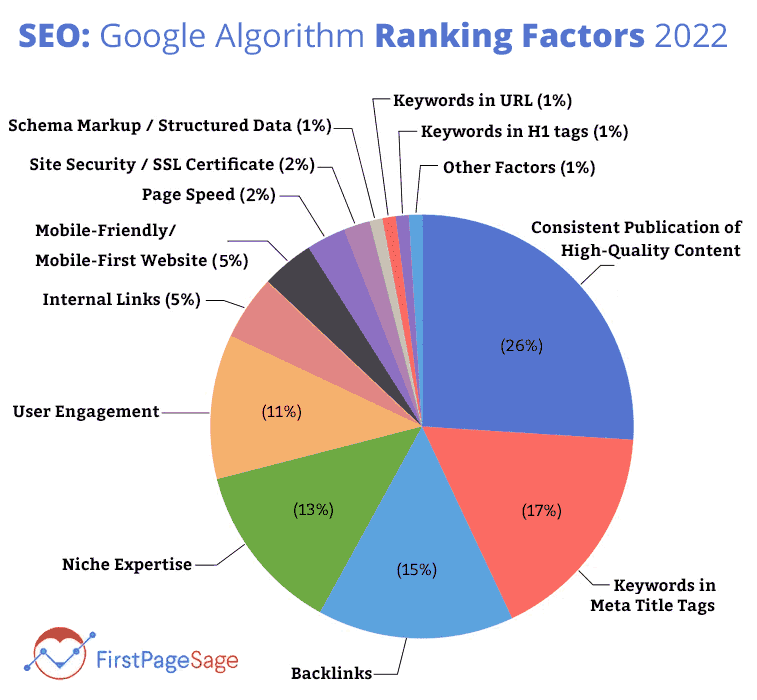
Google uses custom algorithm to rank all web pages in its index. Study made by FirstPageSage shows that some factors play bigger role when ranking a web page.
Google also explains how its algorithm evaluates pages for ranking.
In this WordPress SEO guide we will learn how to optimize our blog and articles to get higher rank. Pages ranked higher than competitors’ will be shown higher in search results and bring more visitors to your website.
Optimize your blog for search engines – On site SEO
There are certain settings that need to be applied to your blog for better SEO. These settings are done once and your blog will be optimized. That is why it is important to do initial optimization of your blog.
Let’s start.
Make your website visible to search engines
WordPress has a built-in feature to hide your blog from search engines. It is used for test sites. For live websites you need to make sure that it can be indexed by search engines.

In the WordPress admin area navigate to the “Settings” → “Reading” page. Make sure the “Search engine visibility” checkbox is unchecked. Remember to click the “Save Changes” button.
Define and stick to single domain structure HTTPS vs. WWW or non-WWW
Google indexes websites with WWW (www.example.com) and same website without WWW (example.com) as 2 different websites. It will be considered as duplicate content and devalue your website. To prevent this you need to stick with one version of your website address. There is not much difference in terms of SEO which one to choose. Non-WWW addresses are shorter. On veppa.com I use a non-WWW address.
HTTPS defines a connection protocol to your website. It is a secure way of sending and getting data from your blog. HTTPS uses SSL certificates that make user communication with your website secure. Google prefers websites with secure connections. So make sure you define your website address with https protocol.
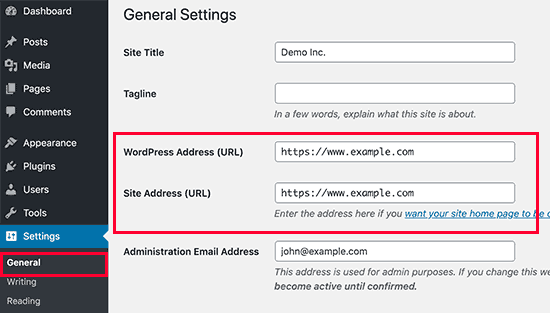
Navigate to “Settings” → “General” page and define your WordPress and website address with HTTPS and with or without WWW. Make sure to use the same address for both fields. Instead of example.com use your own domain name.
It is good to set this setting before adding posts and linking to them. Because when you link to your posts, a full URL with HTTPS and WWW is used. Then If you change this later your old links will not be updated. Changing this in the future may bring some inconsistency in your links that will affect your SEO.
Use search friendly URL
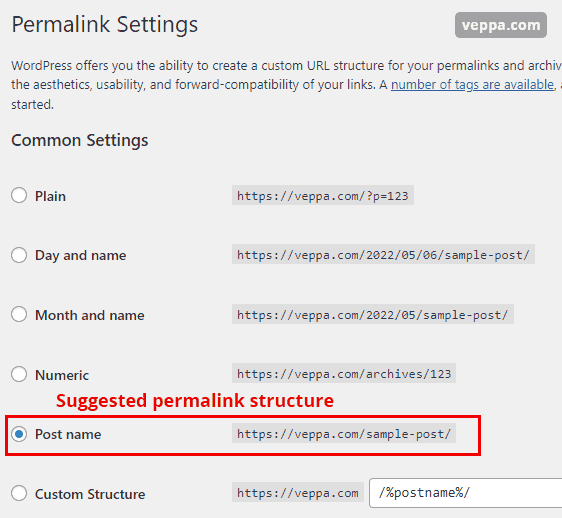
Permalinks need to be readable and understandable. If you write a blog post about “Latest android phones” for example your permalink will be yoursite.com/latest-android-phones/. Search engines and people will know what that URL is about by viewing just your permalinks.
It is a strong SEO signal, so select to use this optimized permalink structure. Navigate to “Settings” → “Permalinks” page on the WordPress admin panel and select the “Post name” option for “Permalink Settings” as shown in image. Remember to save settings and never change your permalink structure after that.
I mentioned this in the blog starter guide as well.
Add your website to google webmaster tools
Now it’s time to add a tool to work with Google Search closely. Google has a tool for webmasters so they can submit their website.
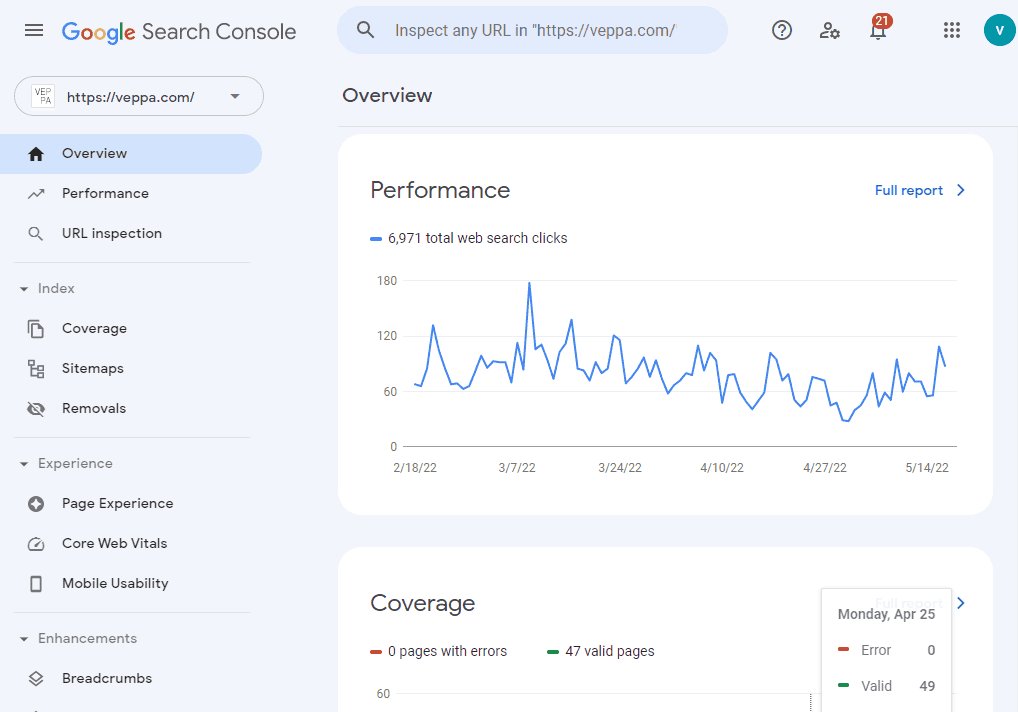
Google search console, also known as Google Webmaster Tools is completely free. You can add all your websites to it including custom coded websites, online shops, etc..
Here are main benefits of using search console:
- View best performing keywords (search terms, words that people searched) for which your blog appears on google.
- View on what position, how many views, how many clicks you get for each keyword.
- See if there are any errors related to your website.
- Check if your blog meets recommended page load time.
- Check if your blog content is indexed.
- How many external and internal links you have to which pages.
Google search console tools are closely used for optimizing your blog for search engines. Go to Google Search Console and register. Add your website with proper https protocol.
We will be adding a sitemap to it in the next step.
Generate and submit sitemap for your website
Sitemap is a map designed for search engines. It lists all important URLs to your content.
WordPress has a built-in feature to generate a sitemap. Navigate to https://yoursite.com/sitemap_index.xml and see how your sitemap looks. Don’t forget to replace yoursite.com with your real domain name.
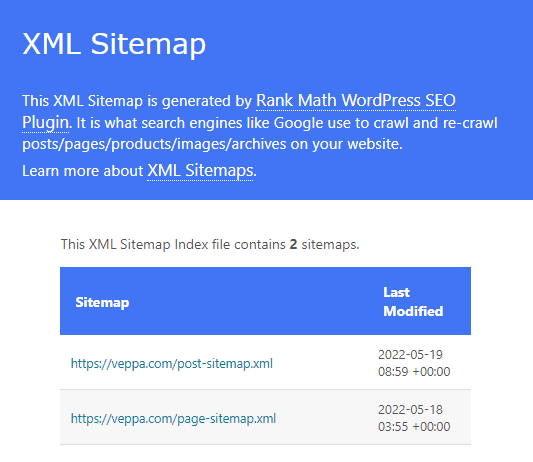
This is how my sitemap looks.
If you have a new blog then it will be mostly empty. But don’t worry XML sitemap is generated automatically. When you add new content to your blog it will be listed there. Sitemap groups various content types then lists each content type in a separate sitemap. Popular SEO plugins like Rank Math SEO give more control over what to include in sitemap.
Now let’s submit your sitemap to google search console.
How to submit a sitemap to Google?
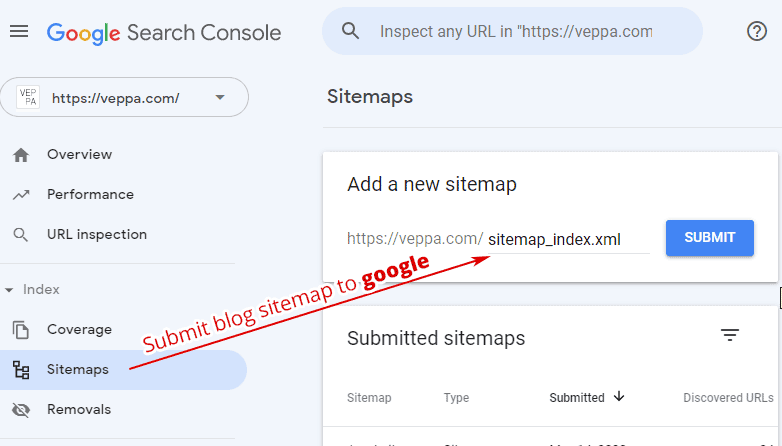
Navigate to “Sitemaps” in Google Search Console and type sitemap_index.xml to “Add a new sitemap” field. Click the “Submit” button.
Google will periodically read your sitemap and index its contents.
Learn more about getting indexed fast in my detailed guide.
Remove pingback and trackbacks
There is an old feature in WordPress that is misused by spammers. When someone links to you from their blog you get a trackback in the form of a comment linking back to their blog. Remember that linking to low quality blogs or spam blogs will hurt your blog’s SEO. 99% of trackbacks are from spam blogs. That is why it is advised to disable it on your WordPress websites.

Go to “Settings” → “Discussion” and uncheck pingback and trackbacks.
Use custom homepage instead of default latest posts
Why use a custom homepage?
Your blog should have a main call to action. That is how you make clear what your blog is about. If you have a project, tutorial, review, registration, e-book, subscription to newsletter, service or anything that makes money promote it on your homepage. Describe your offer and show a clear clickable button.
Also on the homepage you can link to your popular content, show the latest content and general message to introduce yourself or your website.
That is why it is advised to use a custom home page instead of just the latest blog posts.
Check out my homepage to get a sense how it should be formatted.
What is the disadvantage of using the latest posts as a homepage?
- Evergreen and money making content will be hidden and difficult to find.
- At any particular time your blog’s homepage will show only a small portion of your website. Content that has an importance of 1%.
- Homepage is the most linked page with a high authority score. You should show the most important content at any given time. Latest posts are definitely not always the most important content.
- Users coming to your blog post will wonder if you have other interesting content on your blog when they visit your homepage.
- Latest posts are limited to particular time. You do not want your most important page to show very limited time.
How to set up a custom homepage?
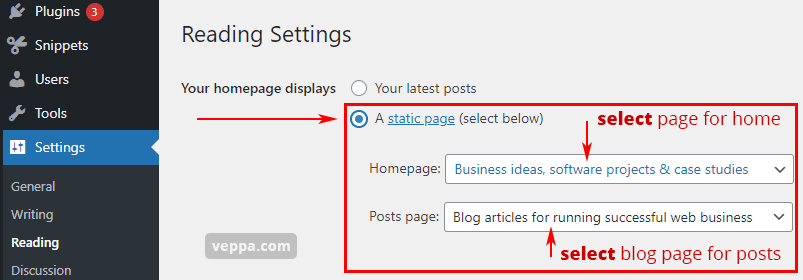
- Add a new page from “Pages” → “Add new”. Put a link or button to your most important content with interesting introduction text and image. Use a page title that describes your whole blog. Add links to most important and money generating content. List your latest 3-5 posts as well. Link to your main categories as well.
- Add a new page for blog content. Use descriptive titles to explain your blog posts’ content. No need to define content here because it will not be visible.
- Navigate to the “Settings” → “Reading” page from the WordPress admin area.
- Choose “A static page” option for “Your homepage displays” field.
- Select in the “Homepage” field homepage that you created.
- Select in the “Posts page” field blog page that you created.
- Save changes by clicking the save button.
By default WordPress blog uses the latest posts for the homepage. That is a big disadvantage for SEO. Make sure to use a custom homepage and link to important content from there.
Use content excerpts
When posts listed in category or blog page where articles listed use excerpt instead of full content. When you use full content google will consider it as duplicate content. Each page should have unique content. This makes google certain which page to show when users search for specific content. Excerpt is small text 20-50 words that describes and introduces to your post.
Website speed
Your blog should be fast and load under 2 seconds on any device. Website speed relies on many factors. There are certain practices to keep your website fast. Stick to the following suggestions to keep your website fast.
- Use fast web hosting.
- Keep the number of plugins low. Try to keep the plugin count less than 20.
- Use a fast responsive theme (for mobile SEO) , preferably without custom fonts.
- Compress images before uploading to blog.
Check website speed with Google PageSpeed Insights. Try to stay in green for all measurements.
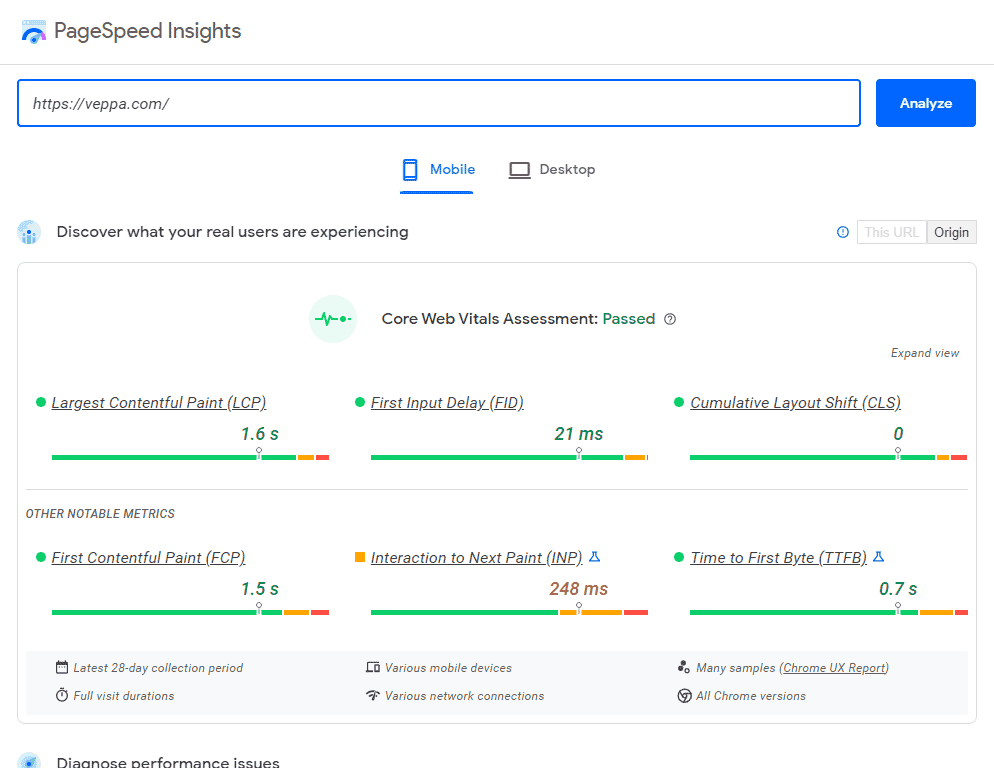
To optimize your WordPress website using built in settings, free plugins and tools read comprehensive speed optimization tutorial.
Safety and security of your website
Website security is another important aspect. Your content can be compromised with moderated spam content, links and posts. Attackers can break your password and post vulnerable links and content to your website.
Use a strong password, so it will be hard to break in.
Moderate your comments manually. If Bbpress, BuddyPress or similar user generated content creation plugins are used then make sure to moderate content. For example forum users can add links in their profile and posts. Remember that linking to low quality or vulnerable content will devalue your website.
For simple blogs without user generated content make sure to disable user registration. Navigate to “Settings” → “General” and uncheck the “Anyone can register” checkbox for the “Membership” field.
Learn how I prevent automated spam bots from reaching my website using free Cloudflare Firewall rules.
Add breadcrumb navigation
Breadcrumb is a hierarchical link structure pointing to parent pages in a website. It shows page location in website structure. From an SEO perspective it will link to parent related pages. We know that linking to related pages is beneficial for SEO. Parent pages for posts are categories. Each parent page lists related articles to that category. This makes blog navigation easy and related to a given topic.
Breadcrumbs can be beneficial for big sites with more than 1k articles. For smaller sites you can link to related categories and other related articles in content which is more preferred for SEO. Breadcrumbs are an easy way to automate linking to parent categories.
WordPress by default does not have breadcrumb features. You can add breadcrumbs with SEO plugins like Rank Math SEO and Yoast. They both have the option to enable breadcrumbs.
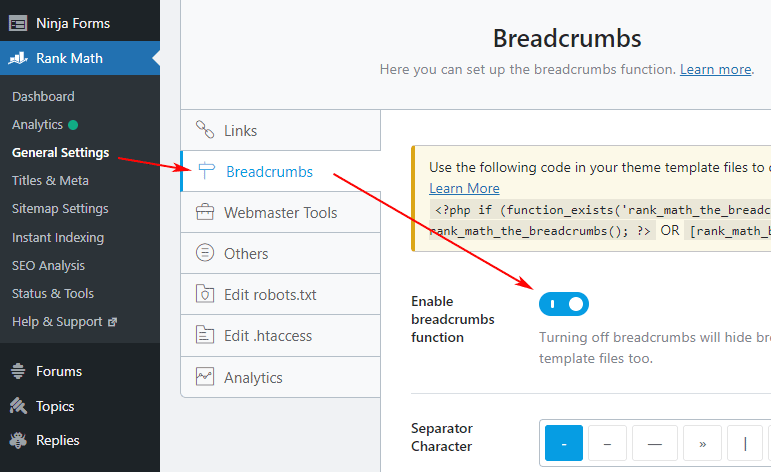
Regularly clean broken links
Over time the blog will have some broken links. It can be external links for changed websites or internal links for changed pages. Links are an important SEO factor that defines content rank.
Outgoing links are also important because when we link to some content it should be relevant to the current page. When an outgoing link points to a 404 page it means your content is not optimized and not updated. Your content is not pointing to a valid page.
We need to fix broken links by finding pages pointing to 404 pages and remove those links or point to updated content URL.
How to find broken links?
- Use WordPress plugin “Broken Link Checker” or search for others.
- Google Chrome extension while browsing your own blog: Check My Links or Broken Link Checker.
- Use external SEO tools like ahrefs, semrush.
Types of broken links and suggested solution to fix them:
- Links pointing to not existing pages, error status code 404. Fix it by removing the link or update by linking to relevant page.
- Links pointing to a URL that redirects to another URL. For example page with link to
url1that points tourl2. Fix it by updating your link to directly linking tourl2. - Additionally fix 404 pages by redirecting to relevant content. This will fix all internal and external links (backlinks) to that 404 page and pass SEO power to relevant content.
Make content sharing easy by adding share button
When great content is discovered it is natural to share it with friends and colleagues. For big articles it is also common to save it for later by sharing. Shared content is trusted, followed and read by followers of sharer. Visitors that come from social media spend more time reading your content and have a higher conversion rate. Because they are prepared and aware of your content.
Having more shares means getting more readers. To get shares add a share button to your blog. Add lightweight native social share button without plugin or check WordPress repository for popular share plugins. Make sure share buttons are not slowing down your website, visible and functional for desktop and mobile devices.
Shared links, users coming from social media, users spending time on your website are all signals to Google that your content is valuable and can boost your content performance for search engines.
These were site wide optimization options for search engines. Now let’s optimize your content for better SEO.
Content optimization – On page SEO
Content optimization is done for each post and page. It is applied when creating new content or optimizing your existing content. Search engines are not smart enough to understand your content. That is why we need to format it with important keywords that describe our content. Keywords are used in title, permalink, subheadings, image alt tags. Also linking to relevant internal and external resources important for on page SEO.
There are a couple SEO plugins that will highlight features for optimizing content for given keywords. I am using Rank Math SEO plugin for optimizing my posts on my blog. You can use Yoast or other WordPress SEO plugins. They all have similar features that optimize your content for search engines.
Keyword research
Content optimization comes with keyword research. You can write great articles but if you do not use most searched keywords then your content will not show up in search results.
Writing and optimizing your content for keywords that people do not search doesn’t make any sense.
Why? Because very few people, if any, will search for keywords that you used in your article without research. That is why it is better to find keywords that users search for.
How to find keywords?
Finding keywords is not difficult. Google search has a built-in feature to show most searched phrases.
Navigate to google search and start typing the topic that you are writing about. Google will show keyword suggestions based on what most people searched.
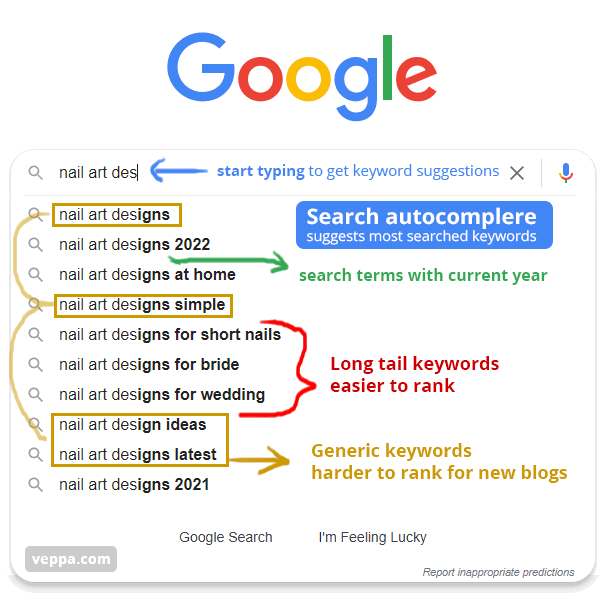
- New blogs target long tail keywords. They contain 4-6 words. Go as specific as possible.
- Long tail keywords have less competition and easier to rank.
- Each long tail keyword should be targeted only by one article. If 2 articles target the same keyword search engines will not show none of them.
- Use current year in title and content when possible.
- For better SEO write content for one category, 10-20 articles. Then move to another related category. Do not write one article from 5 different categories.
Find, analyze and prioritize keywords following my detailed keyword research guide.
Optimize Page title
Page title is visible in google search results. It should contain your primary focus keyword. Keyword should be at the beginning of the title. For example, the title can be “Nail art designs for bride: 2022 trends”. It’s length is 39 characters.
50-60 characters of page title are visible in Google search results. Your page title should be around that length.
Use wording to attract visitors to your content. This will increase organic click through rate for your content on search results.
Optimize page title for long tail keyword, mention specific feature of your content, use numbers, year, Title Case, brackets [], parenthesis (), do not repeat or stuff keywords, write for users, add some emotions, use power words etc. Learn more about page title optimization.
Optimize subheadings
Your post (articles or other pages) title is usually shown on a page with primary heading tags <h1>. It is your primary heading. Heading H1 is used only once on the page because your content page is covering only a single topic.
Good written content is divided into sections with subheadings using H2 and H3 tags. Use additional keywords in subheadings. Remember that heading and subheading text is more important than regular content text.
Subheadings can be used when generating Table Of Contents inside posts for better navigation. Which can also appear in google search results and increase organic CTR.
Long tail subheading with short description has a good chance to be used as a featured snippet in Google. This will also bring more focused traffic to your website.
Optimize content length
Users prefer long form content because it covers all aspects of a given topic. When your content is short users will have some questions left unanswered. Remember that you are writing an article for people with little knowledge about it. So the more you write giving different perspectives and examples the more they will understand your topic. They will be satisfied with your topic and will not return to google for finding out more about that topic.
Also long form of content takes time to read and understand. Users stay more on your page and you will have a low bounce rate. Time on page and low bounce rate is also a ranking factor for search engines.
With long content more than 2000 words you can use your focus keyword more within your content. Search engines will classify your content better because there will be no room for misconception for search engine algorithms.
Pyramid site structure for better SEO
Website structure defines how navigation between topics is built. Website structure is important for grouping your content. There are several site structure types but only winning website architecture should be applied. Check how site structure types effect your SEO.
Pyramid site structure is best for SEO. It will show how content relates to each other with parent and child relation. Links to each page in pyramid site structure should be contextual.
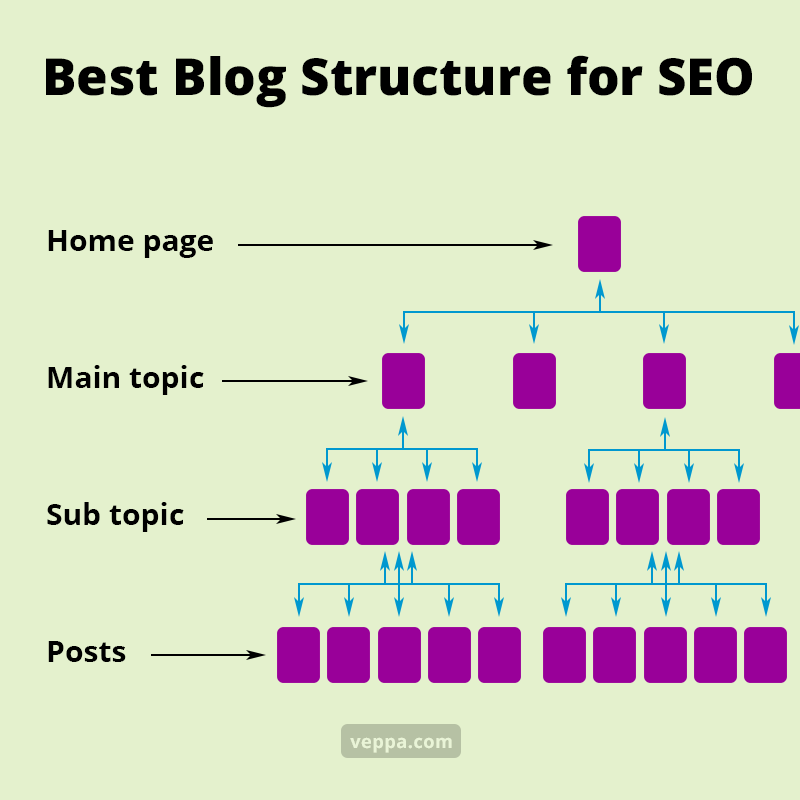
Pyramid site structure looks like this. Your homepage is the main page of your blog. From their link to 5-10 main topics. From each topic link to subtopics. From each sub topic link to your blog posts (articles).
Links should go both ways. Link to child and link to parent. Users entering your website from any page can navigate to parent topics or learn more visiting sub topics.
Pyramid site structure was explained by John Mueller from Google in an SEO office-hours hangout.
Learn how to analyze your current site structure and apply pyramid site structure in WordPress.
Content grouping categories vs tags
Categories and tags help to organize your blog content. For better SEO stick to categorizes and use only one category per post. Use categories to group your content. Prefer using 2 level category structure and try to create pyramid site structure.
For example: Home → Category → Sub category → Blog post.
Tags are useful if you have more than 10k posts. Which is not going to happen for niche blogs.
Internal linking
Linking is the most important part of SEO. Internal linking should be relative to context. Site wide links, on sidebar, footer or menu are not counted as relevant contextual links and do not pass much link value.
Internal linking is used to pass page rank and relate articles with each other. Important articles with lots of information targeting broader focus keywords should be linked more. Google defines page importance by the number of incoming relevant links.
As in pyramid site architecture, the page with the highest page rank is usually the home page. From there you should link to your main 5 content pages. Then from each of those pages link to relevant sub pages targeting more long tail articles.
For blogs monetized with affiliate marketing you can link to a single product review page whenever you mention that product in your articles. This way your review pages will be linked relevantly.
You can optimize internal linking regularly. For example if you can define 5 important pages that convert well. Pages that earn you most of your income. Take note of those pages and search with keywords they are optimized for. Use google to find relevant content on your website with those keywords. Search on Google with this query site:yoursite.com target keyword to find pages that can link to your well converting important pages.
Similarly check Google search console for pages with most incoming links. Then link from those pages to your important pages with relevant introduction text. This way you will pass link juice coming to your page to important pages.
Also it is important to have at least 2-3 incoming internal links for all your articles. Otherwise google will know about those pages from your sitemap.xml but they cannot rank them and understand how to relate those pages to your website. Pages without incoming internal links called orphaned pages. They will have a hard time to show up on google search results if not linked properly.
External linking and using nofollow, sponsored
When you write articles about products you will inevitably link to other external websites. Sometimes you may need to link external articles for citing. We all know in research papers there are always references to other researches. This will allow using their research data in your articles. People reading your article will know how you get certain information. They will validate your article based on data and references you used from external websites.
In terms of SEO linking to external websites from your article has the same effect as research papers citing other data sources. Linking to reliable and relative external articles will add value to your article and will help your articles to rank. External links add thrust to your articles.
Make it a habit to add at least 1 external link in your articles.
There are several tags when using links. For example nofollow, ugc, sponsored.
Let’s explain what they mean:
- rel=”sponsored”: Use the sponsored attribute to identify links on your site that were created as part of advertisements, sponsorships or other compensation agreements.
- rel=”ugc”: UGC stands for User Generated Content, and the ugc attribute value is recommended for links within user generated content, such as comments and forum posts.
- rel=”nofollow”: Use this attribute for cases where you want to link to a page but don’t want to imply any type of endorsement, including passing along ranking credit to another page.
Source google developer blog.
In articles I prefer using nofollow for external links that are not directly related to the current article. For sidebar or footer links I always use nofollow because not all pages will be related to that link.
Important note for affiliate links: always prefer marking affiliate links with sponsored attributes.
Optimize images
Images also need to be optimized for better SEO.
- Keep image size low. Resize and compress images before uploading to your WordPress blog. This will help to load your pages faster.
- Use relative descriptive file names for images. Instead of
image123.jpguselittle-red-shoe.jpg. - Use the alt tag attribute for all images on your blog. Alt attribute provides alternative information about image. When the image is not viewable users will know what this image is about.
Learn more about image optimization.
Optimize article content structure
Use short sentences so your text is more readable. Keep paragraphs also short. Use a single column structure for your content. Enrich content with images and videos. Content without images is boring and not very informative.
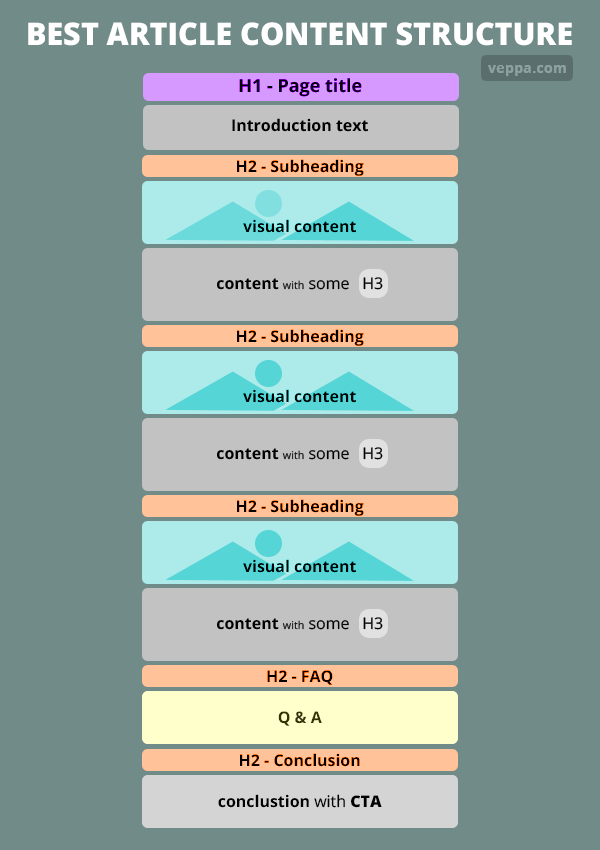
Use introduction at the beginning of your content. Then outline what will be covered in your article.
Divide content structure into 2-3 sections with H2 subheadings. Each of those also can be divided into 2 or more subheadings when needed with H3.
After the section with subheadings use the FAQ section with 5-10 questions related to your article. Give short simple answers. With questions stay within your content topic.
Then add a conclusion section to summarize your article and point out what was covered in your article. Discuss what they have learned and what to do with that information.
Use call to action for learning more by continuing reading more of your content, trying your recommended product, buying or downloading your book, attending your course, subscribing to your blog or YouTube channel, writing about their experience in comments, sharing your article in social media etc.
Avoid posting duplicate content
Duplicate content will devalue your blog. Do not repeat your articles and do not copy content from other websites.
Sometimes duplicate content can be created unintentionally. For example when using multiple categories for your posts. Same posts will appear in many categories with the same title and excerpt. This will be considered as duplicate pages. That is why it is recommended to use only one category for your blog posts. And do not use tags for grouping your posts.
Learn how to detect duplicate content and recover page drops from Google index.
Optimize each content for a separate focus keyword
When optimizing your content for the focus keyword do not use the same keyword in other posts. Why? Because you will compete with yourself for the same keyword in 2 different pages. This will confuse google and humans which of those 2 articles is more important.
As a result both of your pages will not rank and will not show in top position for optimized search terms. So please optimize your content for different focus keywords.
When your website grows to more than 100 posts you may want to check google webmaster tools in order to find if important keywords are showing for 2 different pages. If that is the case think about updating those pages and changing focus keywords for them.
Use structured data markup
Structured data is a way to tell search engines about your content. Generally blog posts and pages use article structured data.
There is also structured data for different components of the same page. They are used in addition with your main structured data. For example breadcrumb, FAQ, review, recipe, video, product has its own structured data format. Use related structured data for each component when possible.
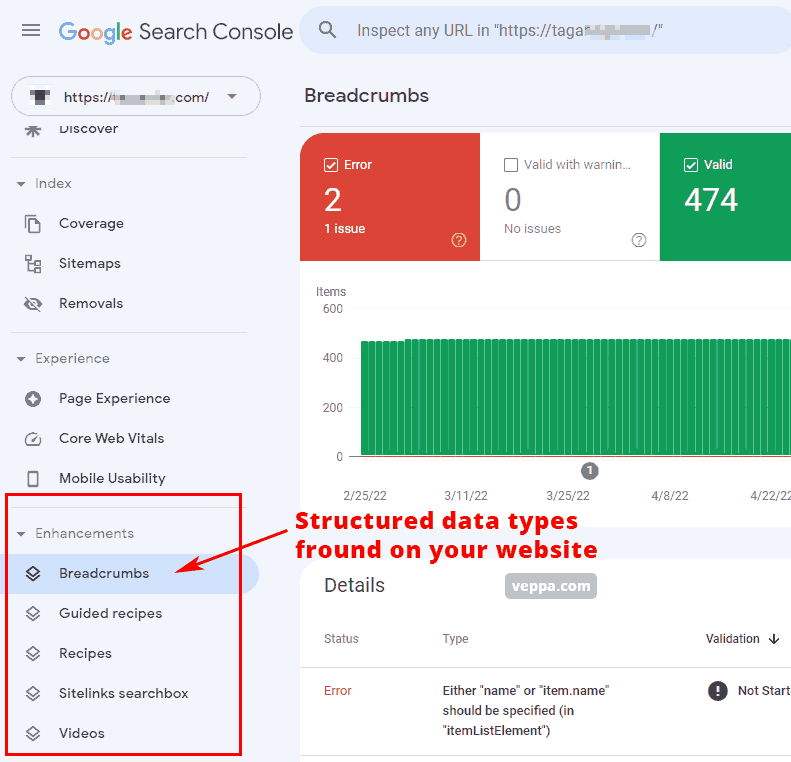
Google search console shows which structured data it found on your website. You can also see errors and warnings if they exist.
WordPress does not have a built-in structured data markup insertion feature. You can add structured data with SEO plugins like Rank Math SEO and custom content type plugins for recipes and reviews.
Page title and description optimization for search intent
Search intent, also known as user intent, is classifying keywords by user needs. Google has years of data to classify popular search queries. It knows what type of content the user is looking for. Make sure that your article meets search intent.
Google has priority to satisfy user intent.
How to find search intent and how to optimize your content for it?
- Search google for the keyword that you are targeting.
- Check results that google shows. Is it a shopping site, information page, how-to tutorial, comparison or review articles?
- Make sure your article is the same type as search results. If your article type is not in search results then there are 2 solutions:
- Find the correct target keyword that shows results similar to your article.
- Change your article to match article types shown in google results.
To write custom page title and description use supported WordPress SEO plugins.
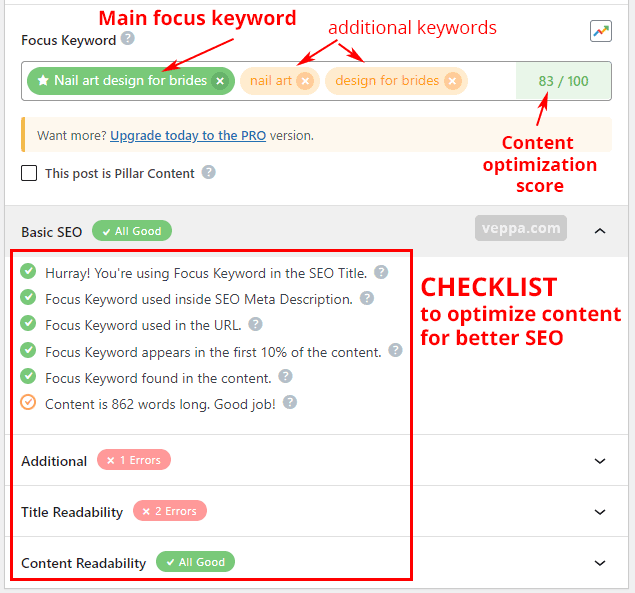
Rank Math SEO plugin helps to write better content by analyzing your article for target keywords. It will suggest improvements related to your content. Most of these on page SEO optimizations I explained in details above. Rank Math SEO makes optimization easy by showing each step as an SEO checklist and gives suggestions for improvement. Try to score 80+ out of 100 points and get a green mark for each article when possible.
You can get similar SEO features with other popular WordPress plugins as well. I like using Rank Math SEO plugin because it encourages me to take action for growing website traffic.
I explained the beginner guide for on-site and on-page SEO. Now we need to learn off-site SEO.
Off site SEO
Links from other related websites to your articles is a major ranking factor for search engines. Actually it has been the main ranking factor since the beginning of Google search engine.
We have very little control over other websites that is why it is hard to get quality links from related websites. There are still some easy link building strategies that you can implement from the beginning.
Be active on social media
Create social accounts for your website and share your articles regularly. Youtube, Twitter, Pinterest, Facebook, Instagram, Reddit can be good places to start. Engage with accounts posting related content, comment and like their postings when appropriate. Some of them will notice and do the same for your content as well.
From your own profile remember to add a link to your website. People interested in your content will follow that link and come to your website.
Add links to your related Social Profiles in “About us” page or the site footer. Connect social profiles using structured data. This will help to link your authority from the various platforms on the internet and your website.
Follow related accounts and hashtags in social media. You may find great article ideas from there as well. Check how twitter hashtags helped to create relevant content and drive traffic for blogs in the WordPress niche.
Engage in forums, blogs, related question answer websites
Related forums and blogs are also great places to share your opinion and knowledge. Answer questions to topics similar to your website. Provide a great answer and link to related content that explains the topic with more details. If you do not have an article you can consider creating one if it fits with your blog content.
Do not use forum footers to link to your website. It is not effective and in some cases may harm your website rankings.
So far we checked how to get external links from our own profiles on external websites. Now let’s check how to get links from authority websites.
Link building from related authority sites
Getting links from authority websites related to your topics is harder. Because you need to communicate with the site owner and offer some benefit. In return, ask for a link to your article.
To get links you can offer to write guest posts that will fit well with their content which is not covered yet. To find a blog offering a guest post you can search google for the keyword “write for us”. For example: coffee table “write for us”.
Then read their requirements and submit your article.
SEO for beginners FAQs
Is WordPress good for SEO?
WordPress has basic SEO settings built in. What is not in WordPress core can be added with powerful SEO plugins. WordPress and plugins are constantly updated with new features following new trends and adapting for better SEO. Customizability of WordPress system makes it best platform for search engine optimization.
Check success story of promo codes website built with WordPress and optimized for SEO for getting 90% traffic from Google reaching 1 million visitors each month.
What are free beginner SEO tools?
Here are 4 free SEO tools for beginners.
- Google Search Console (learn how to add & verify your website)- Best free SEO tool. You can submit sitemap, view structured data, find ranking keywords, view incoming external links and linking domains, see web server issues etc. It is designed by Google for webmasters to understand issues related to their website and optimize for better search engine rankings. Please register and add your blog to the search console.
- Google analytics – helps to track your website traffic. You can view all incoming traffic sources not only google search traffic. Find your best performing content in terms of page views, add goals to track, see time spent on your website and pages. Google analytics is a free tool for understanding your traffic.
- Rank Math SEO WordPress plugin (read my detailed review) – helps you to optimize content for the focus keyword. Can integrate with google analytics and search console to show your keyword rankings. The content scoring feature encourages you to write better optimized articles. Saves time by automatically checking the SEO checklist while you are writing your content. Has a free version as well.
- Google Site Kit – free plugin allows you to track your website performance by combining data from search console + analytics + AdSense.
How to measure SEO success?
To measure SEO success you need to be able to track changes in traffic.
- Add your website to Google Search Console (read guide). In the “Performance” report compare statistics for periods before and after SEO optimizations.
- Similarly Add Google Analytics tracking to your website. Check traffic change in comparison before and after optimizations.
Rank Math SEO and Google Site Kit plugins can show performance and traffic changes inside your WordPress blog admin panel.
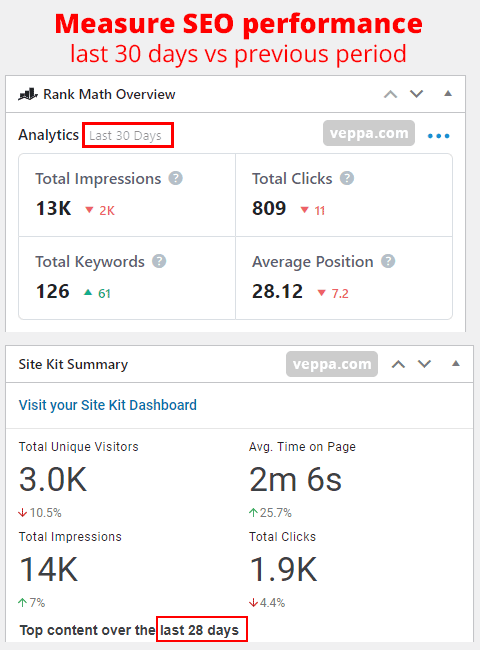
You can view changes in search engine impressions, clicks, visitors, time on page, total keywords, average position in search results. More detailed info can be viewed on a separate dashboard for each plugin.
Can you implement WordPress SEO without a plugin?
- Basic WordPress SEO settings like permalinks, generating sitemap, defining categories, linking articles to each other can be done without plugin.
- Optimized content writing can be done without a plugin but will be difficult to check 20+ optimization criteria manually. Using an SEO plugin will help to save time and do not miss any important optimization.
- Page title, meta description, structured data cannot be done without an SEO plugin.
Final words regarding WordPress SEO Guide
In this WordPress SEO guide for beginners I explained the initial setup to perform for new blogs. You can set them once and no need to touch them again. Basic on site SEO can be done without any SEO plugin.
After completing basic site optimization you can focus on optimization for each article. Finding long tail easy to rank keywords, writing optimized content for the focus keyword and getting incoming links from relevant websites should be done regularly. For article optimization you need to use SEO plugins.
Tracking optimization performance and getting suggestions can be done with free SEO tools from google.
Good luck with your blog optimization.